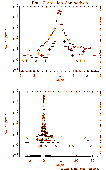
 |
Documentation > SXT Observation Notes > this page |
Image name: Dark_Subtraction_Comparison.png (click image to enlarge)
Image size: 8.42100 KB (500x800)
Date submitted: 05-May-1995

DARK SUBTRACTION COMPARISON
In the course of the VLA campaign on 20-Feb-95 eleven (11) dark images
were obtained of the following kind.
20-FEB-95 20:52:45 QT/H Open /AlMg Full Dark C 28 15108.0 128x 64
.....
20-FEB-95 21:32:45 QT/H Open /AlMg Full Dark C 28 15108.0 128x 64
It has been interesting to use these data to investigate the improvement
in dark frame subtraction that results from using purpose-taken dark
frames over using normal dark subtraction with DARK_SUB.
The figure shows the comparison. Plotted are histograms of the number
of pixels with a given signal versus dark signal level for the dark
corrected images. The plus symbols refer to the residual signal when
the dark frames are corrected with the average of the 11 dark frames.
The asterisks are for the case when the 11 dark frames are dark
corrected with DARK_SUB using the following call.
IDL> darks=dark_sub(index(dk),data(*,*,dk),/interpolate,/float,/norm_exp)
0.20452034 DN shift because of ROI location
IDL> pmm,darks
-11.2640 29.1884
Firstly, it is encouraging that the core distribution is bell-shaped and
centered on zero in both cases. However, the upper curve demonstrates
the dual advantages of using a dark correction frame which is the
average of several dark images and using a dark frame which is taken
close in time to the data images. As a test I sacrificed the advantage of
the averaging and simply used the 20-FEB-95 20:52:45 image to correct
the others. The distribution is still substantially narrower than the
DARK_SUB corrected distribution but not quite good as shown here.
The lower plot shows, for the same data, the improvement in dark spike
correction that results from using the near-in-time average dark frame.
Here there is a very substantial improvement but dark spikes are by no
means eliminated because of the "flashing dark spike" phenomenon. It is
quite fun to watch this corrected dark frame movie and observe the
flashing of different dark spikes on and off.
This analysis demonstrates that for careful work on features where the
best in statistics are desired it is worth taking dark frames within the
PFI sequence and processing the data with averaged dark frames.
L. Acton 5/5/95